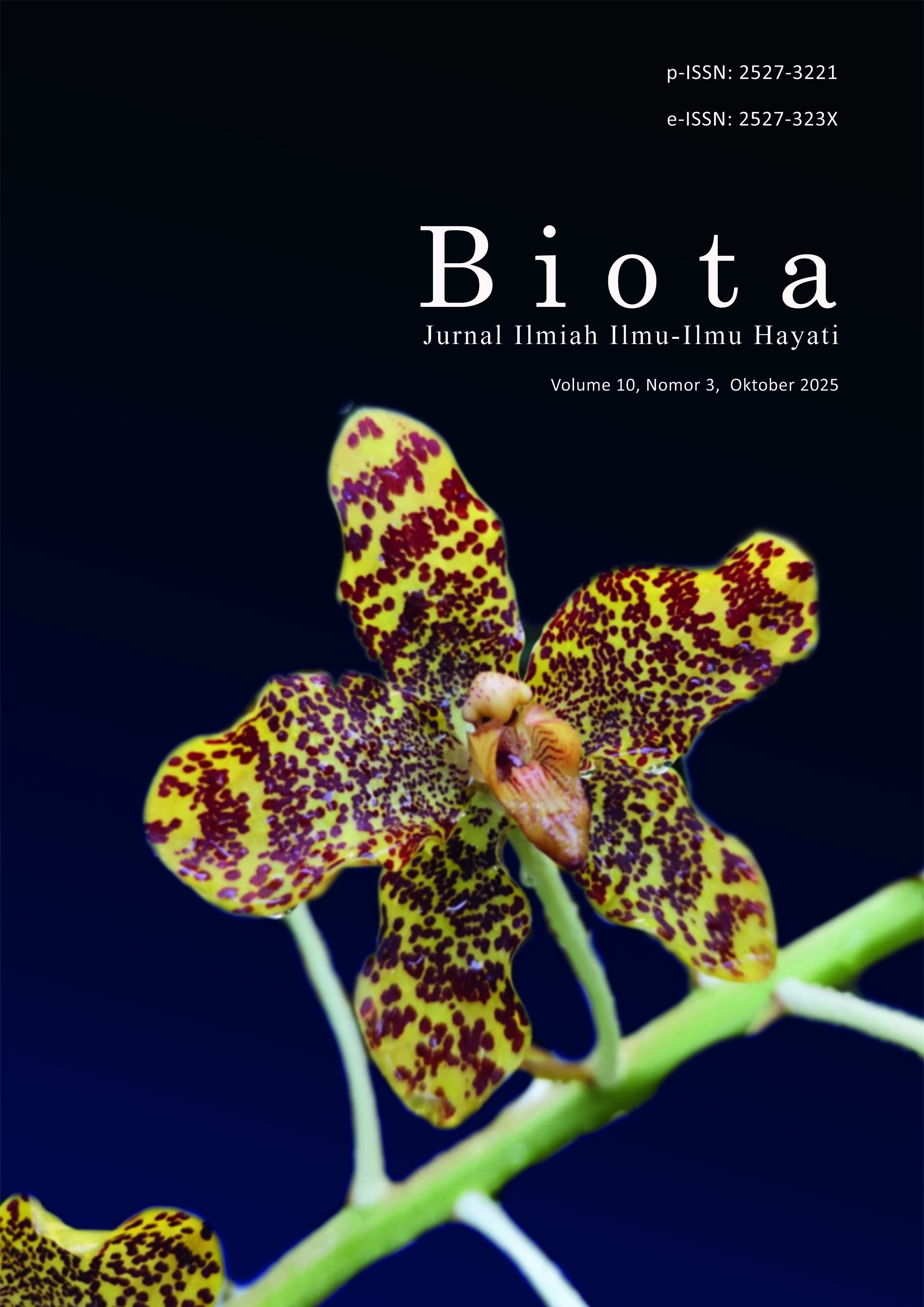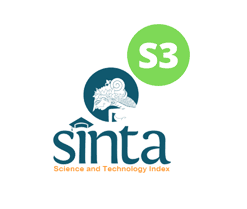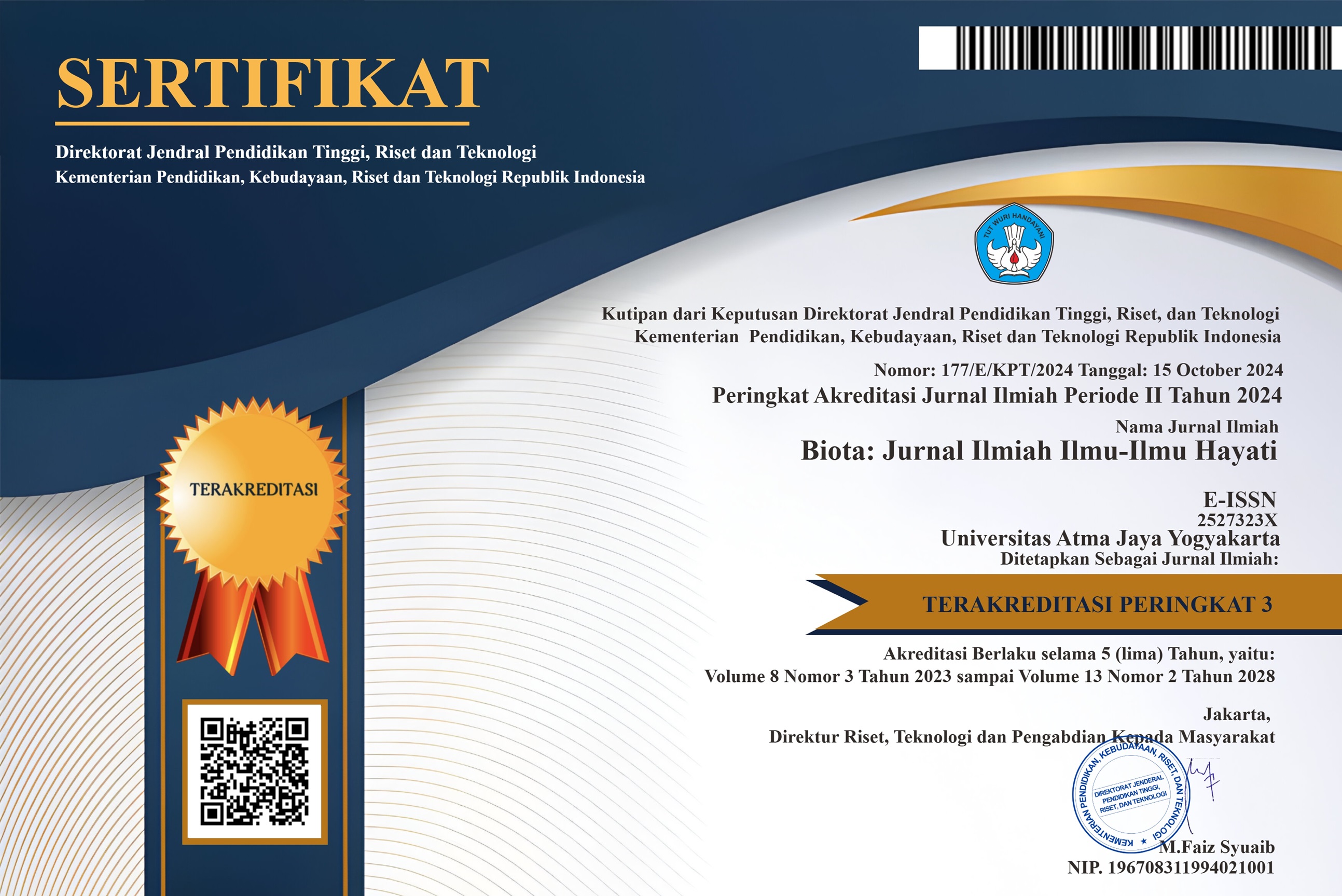Catechin from Avocado Seed (Persea Americana Mill.) Potentially Targets Estrogen Receptor-Alpha: Computational-Based Analysis
DOI:
https://doi.org/10.24002/biota.v10i3.10666Keywords:
Anticancer, avocado seed, estrogen receptor-alpha, molecular docking, pharmacophore modellingAbstract
Avocado seeds (Persea americana Mill.) are known to possess various pharmacological properties, including notable anticancer potential. While preliminary studies have reported the cytotoxic effects of avocado seed extracts on breast cancer cells, there is still a lack of comprehensive research exploring the underlying molecular mechanisms responsible for these effects. This study explores bioactive compounds found in avocado seeds as potential agents targeting estrogen receptor alpha (ERα), a key biomarker in breast and cervical cancers. The investigation employs a range of computational approaches, including the Lipinski Rule of Five, ADME/Tox predictions, pharmacophore screening, and molecular docking analysis. Of the ten tested compounds, seven passed the Lipinski Rule of Five. ADME/Tox analysis revealed that most compounds exhibited adequate human intestinal absorption (HIA), poor blood-brain barrier (BBB) penetration, moderate Caco-2 permeability, and good plasma protein binding (PPB), while some were predicted to be mutagenic or carcinogenic. Pharmacophore modeling yielded an AUC of 0.87, with procyanidin B scoring 45.09 as a hit compound. Molecular docking revealed catechin, hyoscyamine, and atropine had the lowest Gibbs free energy (-5.15, -0.10, -0.07 kcal/mol). Among the compounds, catechin in avocado seed shows the highest potential for development as an ER-targeted anticancer agent.
References
Ademiluyi, A.O., Oyeniran, O.H., Del Prado-Audelo, M.L., Romero-Montero, A., Leyva-Gómez, G., Dini, I., Habtemariam, S., Setzer, W.N., Sharifi-Rad, J., Calina, D. (2025). Procyanidins as potential anticancer agents: mechanisms of action, bioavailability challenges and therapeutic opportunities. Med Oncol 42(7): 251. https://doi.org/10.1007/s12032-025-02814-1.
Ahmad, I., Kuznetsov, A.E., Pirzada, A.S., Alsharif, K.F., Daglia, M., Khan, H. (2023). Computational pharmacology and computational chemistry of 4-hydroxyisoleucine: Physicochemical, pharmacokinetic, and DFT-based approaches. Frontiers in Chemistry 11. https://doi.org/10.3389/fchem.2023.1145974
Alkhalaf, M.I., Alansari, W.S., Ibrahim, E.A., ELhalwagy, M.E.A. (2019). Anti-oxidant, anti-inflammatory and anti-cancer activities of avocado (Persea americana) fruit and seed extract. Journal of King Saud University - Science 31(4): 1358–1362. https://doi.org/10.1016/j.jksus.2018.10.010.
Astuti, N.M.W., Laksmiani, N.P.L., Wirasuta, I.M.A.G. (2017). Aktivitas Induksi Apoptosis Ekstrak Metanolik Biji Alpukat Pada Sel WiDR Secara Flowcytometry. Prosiding Senastek 17–21.
Bangar, S.P., Dunno, K., Dhull, S.B., Kumar Siroha, A., Changan, S., Maqsood, S., Rusu, A.V., (2022a). Avocado seed discoveries: Chemical composition, biological properties, and industrial food applications. Food Chemistry 16: 100507. https://doi.org/10.1016/j.fochx.2022.100507.
Bhuyan, D.J., Alsherbiny, M.A., Perera, S., Low, M., Basu, A., Devi, O.A., Barooah, M.S., Li, C.G., Papoutsis, K. (2019). The Odyssey of Bioactive Compounds in Avocado (Persea americana) and Their Health Benefits. Antioxidants (Basel) 8(10): 426. https://doi.org/10.3390/antiox8100426.
Chung, S.-H., Franceschi, S., Lambert, P.F. (2010). Estrogen and ERα: Culprits in Cervical Cancer?. Trends Endocrinol Metab 21(8): 504–511. https://doi.org/10.1016/j.tem.2010.03.005.
Dabas, D., Elias, R.J., Ziegler, G.R., Lambert, J.D. (2019). In Vitro Antioxidant and Cancer Inhibitory Activity of a Colored Avocado Seed Extract. International Journal of Food Science 6509421. https://doi.org/10.1155/2019/6509421
Dange, V.N., Shid, S.J., Magdum, C.S., Mohite, S.K. (2017). A Review on Breast cancer: An Overview. Asian Journal of Pharmaceutical Research 7(1): 49-51. https://doi.org/10.5958/2231-5691.2017.00008.9
Dewi, N.L.P.L., Ginarsih, N.M.A. (2021). Molecular Docking Ellagic Acid As An Anti-Photoaging Agent In Silico. Acta Holist, Pharm 3: 22–30.
Furth, P.A., Wang, W., Kang, K., Rooney, B.L., Keegan, G., Muralidaran, V., Wong, J., Shearer, C., Zou, X., Flaws, J.A. (2023). Overexpression of Estrogen Receptor α in Mammary Glands of Aging Mice Is Associated with a Proliferative Risk Signature and Generation of Estrogen Receptor α–Positive Mammary Adenocarcinomas. The American Journal of Pathology 193(1): 103–120. https://doi.org/10.1016/j.ajpath.2022.09.008
IARC. (2024). Cancer Today, Retrieved January 5, 2025, from https://gco.iarc.who.int/en.
Kopon, A.M., Baunsele, A.B., Boelan, E.G. (2020). Skrining Senyawa Metabolit Sekunder Ekstrak Metanol Biji Alpukat (Persea Americana Mill.) Asal Pulau Timor. Akta Kimia Indonesia 5(1): 43-52. https://doi.org/10.12962/j25493736.v5i1.6709
Li, X.-X., Liu, C., Dong, S.-L., Ou, C.-S., Lu, J.-L., Ye, J.-H., Liang, Y.-R., Zheng, X.-Q. (2022). Anticarcinogenic potentials of tea catechins. Frontiers in nutrition 9: 1060783. https://doi.org/10.3389/fnut.2022.1060783
Lipinski, C.A. (2004). Lead- and drug-like compounds: the rule-of-five revolution. Drug discovery today. Technologies 1(4): 337–341. https://doi.org/10.1016/j.ddtec.2004.11.007
Muchtaridi, M., Syahidah, H.N., Subarnas, A., Yusuf, M., Bryant, S.D., Langer, T. (2017). Molecular Docking and 3D-Pharmacophore Modeling to Study the Interactions of Chalcone Derivatives with Estrogen Receptor Alpha. Pharmaceuticals (Basel, Switzerland) 10(4): 81. https://doi.org/10.3390/ph10040081
Naufa, F., Mutiah, R., Yen, Y., Indrawijaya, A. (2021). Studi in Silico Potensi Senyawa Katekin Teh Hijau (Camellia sinensis) sebagai Antivirus SARS CoV-2 terhadap Spike Glycoprotein (6LZG) dan Main Protease (5R7Y). J.Food Pharm.Sci 584–596.
Pollastri, M.P. (2010). Current protocols in pharmacology Chapter 9, Unit 9.12. Overview on the Rule of Five https://doi.org/10.1002/0471141755.ph0912s49
Rahwawati, J., Maryati, M., Yuliani, R. (2022). Cytotoxic and Antiproliferation Activity of n-Hexane Fraction of Avocado seed (Persea americana Mill.) on MCF7 cell. Pharmacon: Jurnal Farmasi Indonesia 19(1): 35–44. https://doi.org/10.23917/pharmacon.v19i1.18274
Ratu, B.D.P.M., Bodhi, W., Budiarso, F., Kepel, B.J., Fatimawali, ., Manampiring, A. (2021). Molecular Docking Senyawa Gingerol dan Zingiberol pada Tanaman Jahe sebagai Penanganan COVID-19. Jurnal e-Biomedik 9(1): 126–130. https://doi.org/10.35790/ebm.v9i1.32361
Suryati, S., Dillasamola, D., Rahadiant, F. (2016). Pengaruh Ekstrak Etanol Daun Vernonia Amygdalina, Del Terhadap Kadar Kreatinin Serum Mencit Putih Jantan. Jurnal Sains Farmasi dan Klinis 3(1): 79–83.
Tsouh Fokou, P.V., Kamdem Pone, B., Appiah-Oppong, R., Ngouana, V., Bakarnga-Via, I., Ntieche Woutouoba, D., Flore Donfack Donkeng, V., Tchokouaha Yamthe, L.R., Fekam Boyom, F., Arslan Ateşşahin, D., Sharifi-Rad, J., Calina, D. (2025). An Update on Antitumor Efficacy of Catechins: From Molecular Mechanisms to Clinical Applications. Food Science & Nutrition 13: e70169. https://doi.org/10.1002/fsn3.70169
Wardani, W.N.A.& E.K. (2022). Efek Samping Kemoterapi Secara Fisik Pasien Penderita Kanker Servik. Prosiding Seminar Nasional & Internasional 2(9): 97–106.
Zhao, Z., Hamid, N., Qian, L., Gutierrez-Maddox, N., Kam, R., Kantono, K., Wang, K., Lu, J., Le, T.T. (2022). The effects of roasting on antioxidant and anticancer activities of fermented Hass avocado seeds. Frontiers in Food Science and Technology 2: 986868. https://doi.org/10.3389/frfst.2022.986868
Downloads
Published
How to Cite
Issue
Section
License
Copyright (c) 2025 Martiza Aulia, Fahrana Rosani, Tarisa Nurafni Romadhona, Lintang Gusti Kinanti, Kevin Gabriel, Agus Rusdin, Dhania Novitasari

This work is licensed under a Creative Commons Attribution-NonCommercial 4.0 International License.
Authors who publish with Biota : Jurnal Ilmiah Ilmu-Ilmu Hayati agree to the following terms:
- Authors retain copyright and grant the Biota : Jurnal Ilmiah Ilmu-Ilmu Hayati right of first publication. Licensed under a Creative Commons Attribution-NonCommercial 4.0 International License that allows others to share the work with an acknowledgment of the work's authorship and initial publication in this journal.
- Authors are able to enter into separate, additional contractual arrangements for the non-exclusive distribution of the journal's published version of the work (e.g., post it to an institutional repository or publish it in a book), with an acknowledgment of its initial publication in Biota : Jurnal Ilmiah Ilmu-Ilmu Hayati, and as long as Author is not used for commercial purposes.













